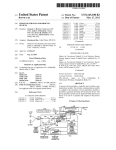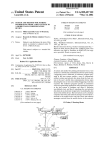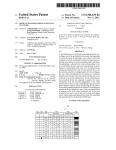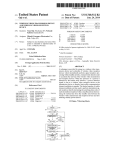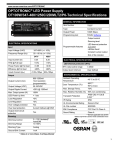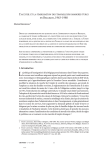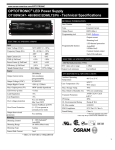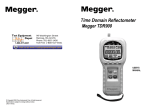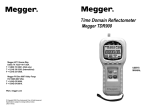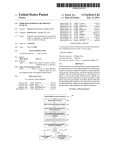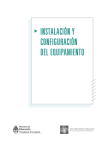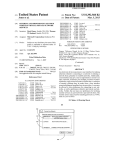Download m WW»)
Transcript
US008258654B2 (12) Ulllted States Patent (10) Patent N0.: Parsons (54) (45) Date of Patent: 5,586,048 A * 12/1996 Coveley ...................... .. 702/189 PORTABLE POWER SWITCHING 5,598,042 A D381,632 S . . . 5,650,771 Inventor: (73) Ass1gnee: Leviton Manufacturing Co., Inc., Kevin Parsons, W1lsonv1lle, OR (US) _ Melville, NY(US) A 1/1997 MIX er a1~ 7/1997 Overthun * 7/1997 ~ . ~ ~ ~ - 5,673,022 A 9/1997 Patel 5,748,466 A 5/ 1998 McGivern et a1. 5,764,146 A * 6/1998 Baldwin et a1. ............. .. 340/567 4/1999 Paulus et a1. A 5/1999 5,982,103 A Mosebrook et a1. 11/1999 Mosebrook et a1‘ patent 15 extended or adjusted under 35 6 078 253 A * 6/2000 Fowler ““““““““““““ “ 340/501 USC 15402) by 172 days- 6,380,852 B1 4/2002 Hartman etal. (21) Appl. N0.: 12/503,3s1 Filed: ............................. .. 340/656 9/1997 Holcomb et a1‘ 5,905,442 Subject‘ to any dlsclalmer, the term ofthls Lee 5,670,940 A 5,898,407 A * ( ) Notlce. (Commued) Jul- 15, 2009 FOREIGN PATENT DOCUMENTS KR (65) 20-1998-0041190 Prior Publication Data US 2011/0012433 A1 (51) Sep. 4, 2012 WIRELESS OCCUPANCY SENSING WITH (75) (22) US 8,258,654 B2 Int- ClH01H 35/00 9/1998 (Continued) Jan. 20, 2011 OTHER PUBLICATIONS U.S. Appl. No. 12/434,543, ?led May 1, 2009, not yet published, 23 pages, (2006.01) (52) US. Cl. (58) Field of Classi?cation Search ................ .. 307/117, ..................................................... .. 307/116 _ (Commued) 307/116 . See application ?le for complete search history. . d Prlmary Exammer i Jare Fureman Assistant Examiner * Adi Amrany (56) References Cited (74) Attorney, Agent, McCollom PC or Firm * Marger Johnson & US. PATENT DOCUMENTS 4,305,021 A * 12/1981 Schreiden ................... .. 315/159 2 i , galvln et a1~a1~~~~ , ameron et 4,820,938 A * . . .... .. Mix et a1‘ ' ' ' ' ' ' ' ' ' ABSTRACT A portable switching device may include a Wireless receiver ~ ~ - ' ' ' ' “ 307“ 17 to recelve'a W1reless slgnal from an occupancy sensor, and a 4,890,093 A 4. 121989 Allison et a1‘ “““““““ “ 340/567 poWer swltch to control poWer to a load 1n response to the 5,157,273 A 10/1992 Medendorp et a1‘ Wireless signal. In some embodiments, the Wireless signal 5,374,854 A * 12/ 1994 Chen ........................... .. 307/117 may include an occupancy signal that indicates the occupied 5,448,290 A 4/l989 (57) ~~~~ ~~ 9/1995 vaflzeeland 2 state of a monitored space. In other embodiments, the Wire 223E531‘ less signal may include a detector signal that requires further 534893827 A 2/ 1996 Xia 5,534,850 A * 7/1996 processing to determine the occupied state of the space. 5,538,181 A 7/1996 Simmons et a1. Lee ............................. .. 340/565 19 Claims, 7 Drawing Sheets OCCUPANCY SENSOR 56 POWER SOURCE S 58 m WW») DETECTOR | SIGNAL 6i 64 63 PROCESSOR "'60 F --------- --~ USER i DETECTOR i-' H INTERFACE PORTABLE SWITCHING DEVICE P70 WIRELESS RECEIVER P72 _q SIGNAL PRocEssoR P80 USER INTERFACE SWITCH CONTROL LOGIC , ___________ 1 POWER SWITCH .............. -. 88 _> US 8,258,654 B2 Page 2 U.S. PATENT DOCUMENTS 6,418,324 6,587,739 6,703,786 6,720,874 6,731,024 6,756,998 6,888,323 6,909,921 6,940,230 6,956,493 6,993,417 7,027,416 7,071,672 7,123,139 7,155,317 7,230,532 7,415,310 7,511,613 7,522,036 7,541,924 7,544,941 7,626,339 7,688,005 7,765,033 7,830,133 7,918,406 7,940,167 8,009,042 8,018,166 2002/0023233 2002/0135476 2003/0073342 2005/0030177 2005/0132408 2006/0125624 2007/0075852 2007/0132318 2007/0222584 2007/0272293 2007/0276548 2007/0290621 2008/0024007 2008/0068204 2008/0094210 2008/0111491 2008/0136663 2008/0176608 2008/0218099 2008/0303661 2009/0049466 2009/0101386 2009/0102679 2009/0135006 2009/0137163 2009/0195704 2009/0219245 2009/0278472 2010/0007801 2010/0207759 2010/0237711 2010/0237781 2010/0237783 2010/0277306 2010/0308664 2010/0315196 2011/0036699 2011/0074225 2011/0080529 2011/0090042 2011/0210622 2011/0282509 7/2002 7/2003 3/2004 4/2004 5/2004 6/2004 5/2005 6/2005 9/2005 10/2005 1/2006 4/2006 7/2006 10/2006 12/2006 6/2007 8/2008 3/2009 4/2009 6/2009 6/2009 12/2009 3/2010 7/2010 11/2010 4/2011 5/2011 8/2011 9/2011 2/2002 9/2002 4/2003 2/2005 6/2005 6/2006 4/2007 6/2007 9/2007 11/2007 11/2007 12/2007 1/2008 3/2008 4/2008 5/2008 6/2008 7/2008 9/2008 12/2008 2/2009 4/2009 4/2009 5/2009 5/2009 8/2009 9/2009 11/2009 1/2010 8/2010 9/2010 9/2010 9/2010 11/2010 12/2010 12/2010 2/2011 3/2011 4/2011 4/2011 9/2011 11/2011 Abrams et al. ................ .. 700/83 Tannenbaum 610-2008-010549 10-2009-0130800 Energy ConservationiHome and Of?ce, echo?ex, EnOcean Alli ance, Oct. 20, 2008 (earliest suspected availability date extracted from digital document), Squamish, BC, Canada, 41 pages. Molnar et al. .............. .. 307/147 Bilger Null et al. Bilger Myron et al. Youngblood Osann, Jr. ................... .. 700/291 KriZ Drusenthal Sweeney Tran ............................ .. 700/259 Albsmeier et al. Bovee et al. Wang Preuss et al. ................ .. 340/531 Elwell Gorman et al. Paton .......................... .. 315/155 Reid Perry .......................... .. 700/275 Williams et al. Rosen Steiner et al. Steiner et al. Soccoli et al. Bach, DEMO of Self-Powered PIR Radio Sensor, Application Note AN013, EnOcean, Jan. 2007, 8 pp. User Reference Guide, 8 Outlet Power Strip with Personal Sensor, IDP-3050-A version 2, Nov. 2007, Isole, WattStopper, Santa Clara, CA, 4 pp. Installation Instructions, 8 Outlet Power Strip with Personal Sensor, IDP-3050-A version 2, Jan. 2008, ISOLe, WattStopper, Santa Clara, CA, 8 pp. Bach, Power Supply LayoutiLayout considerations for Line-Power Supplies, Application Note 101, EnOcean, Jan. 20, 2009, 4 pp. Bach, Motion SensoriDesign Example for an Ambient Light Pow ered PIR, Application Note 306, EnOcean, Jan. 21, 2009 (earliest suspected availability date extracted from digital document), 7 pp. Frequently Asked Questions, Airwave, Ledalite, Mar. 1, 2009, 6 pp. Technical Guide, Airwave, Ledalite, Mar. 5, 2009, 14 pp. Airwave Speci?cation Overview, Airwave, Wireless by Ledalite, Mar. 4, 2009, 2 pp. Isole Plug Load Controls, WattStopper, Santa Clara, CA, Jan. 7, 2009, 8 pp. Concept of a Occupancy Sensor Light Switch, Application Note AN012, EnOcean, Sep. 2007, Germany, 2 pp. Bach, Self-Powered PIR Radio Sensor starting at 40 lx, Application Note AN013A, EnOcean, Aug. 2007, Germany, 4 pp. Bach, Ambient light powered occupancy sensor for Indoor, Applica tion Note, EnOcean, Dec. 2006, Germany, 3 pp. Heath/Zenith Wireless Outdoor Power Control, Model 6022, O’Meany McKinney et al. Geyer Albsmeier et al. Dahley et al. HeathCo LLC, Bowling Green, KY, 2007, 20pp. Ostrovsky et al. .......... .. 340/527 New Occupancy/Vacancy Sensor Sets a Higher Performance Stan dard, Lutron Electronics Co., Inc., Coopersburg, PA, Jun. 9, 2009, 1 Schmidt et al. Schmidt et al. Albsmeier et al. Schmidt UZunovic et al. page. Black, Rich, Lutron RF Technology . . . Reliable, First, Forward Thinking, Lutron Electronics Co., Inc., Coopersburg, PA, Aug. 2006, 15 pp. Carmen et al. Kropelin et al., APC UPS Daemon, “APCUPSDE User Manual,” Jul. 31, 2009, 111 pp. Bulogics, “Home AutomationiLight, Your Way, Product Over Paradiso et al. ............. .. 340/540 view,” 2008, 11 pp.Bulogics, Our Gadgets: USB Shutdown Stick, Clarket a1. ................. .. 315/113 Budampati et al. ........... .. 307/19 Spira Courtney et al. Budampati et al. ......... .. 455/572 Newman Chick Schoettle et al. Schoettle Schoettle ................. .. 340/8 1 5 .4 Schoettle .................... .. 340/ 540 Schoettle .................... .. 439/894 Bombara Frankel et al. Cooper et al. Sloan et al. ................. .. 340/540 Parsons Mar. 31, 2010, 1 page. Bulogics, Our Gadgets: USB Shutdown Stick, Mar. 31, 2010, 1 page. EMX Industries, “BlueGuard Bluetooth Enabled Stand-Alone Access Control,” Cleveland, OH, May 6, 2009, 2pp. Leviton, S1000/ S2000 Series, Leviton Surge Strips, “Quality Protec tion. Everyday Application,” Product Info Sheet, May 10, 2010, 2 pp. Leviton, TVSS Master Specs, Section 16478, Transient Voltage Surge Suppression (Surge Protective Devices), May 10, 2010, 6 pp. National Electrical Manufacturers Association, “NEMA Guide Pub lication WD Jul. 20004Occupancy Motion Sensors,” 2000, 16 pp. Northern Softworks, “Welcome to Northern Softworks,” Lights Out, Mills et al. .................. .. 315/294 . 307/116 Dupre et al. 315/86 Dupre et al. . 315/149 Leinen et al. ............ .. 340/539.3 Face et al. ................... .. 307/104 Dec. 15,2009, 1 page. SmartHomeUSA, “Smart Strip, Power StripiUser’s Guide,” for Models LCGl, LCG2, LCG3, LCG4, LCG5, Dec. 15, 2009, 4 pp. SmartHomeUSA, “Smart Strip Power Strip with Coax, Fax & Modem Protection,” Dec. 15, 2009, 5 pp. Corn?eld Electronics, Inc., “How Does TV-B-Gone Work?,”2009, 1 page. Leviton, “Infrared Repeater systemiComponent Speci?cations,” Schmidt et al. Part Nos. 47621-MIE, 47621-CMS, 47603-110, 2001, 2 pp. U.S. Appl. No. 12/778,014, ?led May 11, 20 10, not yet published, 30 Delnoij et al. .............. .. 307/117 pages. Wong U.S. Appl. No. 12/649,697, ?led Dec. 30, 2009, not yet published 18 Leonard et al. .............. .. 340/5.1 pages. . 307/116 Yegin et al. ................. .. 700/295 FOREIGN PATENT DOCUMENTS KR KR OTHER PUBLICATIONS Doviak et al. 12/2008 12/2009 OPUS-FUNK plus, Jager Direkt GmbH & Co., Jul. 2, 2006, Ger many, 2 pp. Wireless Ceiling Multi Sensor 360°, SR-MDS, thermokon Sensortechnik GmbH, Dec. 2007, Germany, 7 pp. BlueGuard Bluetooth Enabled Stand-Alone Access Control, EMX Industries, Inc., Cleveland, OH, May 6, 2009, 2pp. US 8,258,654 B2 Page 3 Enocean, “PerpetuumiMaintenance-Free Wireless Switches & Sensors,” Vol.4, Issue 05, International Edition, Apr. 2007, 56 pages. Enocean, “Concept of a Occupancy Sensor Light SWltChiRF Tech nology Without Batteries,” Bach, Aug. 2006, 2 pages. International Search Report and Written Opinion for PCT/US2011/ 024421, dated Oct. 14, 2011, 9 pages. Vishay Semiconductors, “Data Formats for IR Remote Control,” Document No. 80071, Rev. 1.8, Jul. 28, 2010, pp. 11-14. Enocean, “DEMO of Self-Powered PIR Radio SensoriRF Technol ogy Without Batteries,” Bach, Jan. 2007, 8 pages. Enocean, “Indoor Mounting of Solar Powered SensorsiRF Tech Leviton Manufacturing Co., Inc., “Infrared Ceiling Mounted Occupany Sensors,” Installation Instructions, 2005, 2 pages. nology Without Batteries,” Bach, Sep. 2006, 3 pages. * cited by examiner US. Patent Sep. 4, 2012 Sheet 1 of7 US 8,258,654 B2 OCCUPANCY SENSOR |-\118 16~§ 10 12 BUILDING \v, g 14 PORTABLE SWITCHING WIRING > LOAD DEVICE FIG.1 OCCUPANCY SENSOR |-18 16~§ 20 12 BUILDING WIRING ‘v; S PORTABLE ’ LOAD |V22 SWITCHING DEVICE _ LOAD I 24 OCCUPANCY sENsOR F18 12 16~§ 26 i \v/ 8 16~% PORTABLE 3 BUILDING SWITCHING g WIRING DEVICE \V/ - LOAD F30 PORTABLE SWITCHING —- LOAD F32 28~ DEVICE FIG.3 US. Patent Sep. 4, 2012 Sheet 2 of7 US 8,258,654 B2 OCCUPANCYSENSOR 38*v DETECTOR I 36 I 34h~ SIGNAL PROCESSOR I 40 “g 42 PORTABLE SWITCHING DEVICE OCCUPANCY SENSOR 52 DETECTOR 54 "'5 48 12 ‘v7 8 BUILDING WIRING PORTABLE SWITCHING DEVICE <| SIGNAL PROCESSOR I FIG.5 14 LOAD US. Patent Sep. 4, 2012 Sheet 3 of7 US 8,258,654 B2 OCCUPANCY SENSOR 56 POWER SOURCE |-\'64 DETECTOR 62 ' DETECTOR l SIGNAL 66 TRANSIvIITTER M)» --------- : 58 : 68 i PROCESSOR (“60 g i I Fm-USI'ER'mE :—>' I‘_' INTERFACE : l I- _ _ _ _ _ _ _ _ _ _ ___| I I I- __________ ___l | I- _ _ _ _ _ _ _ _ _ _ ___l PORTABLE SWITCHING DEVICE 7° ____ “(1:72. ____ “(71%! WIRELESS F SIGNAL 1 ;" USER "; RECEIvER LRROCESSORj L INTERFACE j 74~ SWITCH CONTROL LOGIC I i (1) wk) 884 86 > POWER SWITCH 7 I 6 I 78 S g 88 I' """""" "'I > v: POWER SWITCH '—S——> US. Patent Sep. 4, 2012 Sheet 4 of7 US 8,258,654 B2 US. Patent Sep. 4, 2012 Sheet 5 of7 US 8,258,654 B2 US. Patent Sep. 4, 2012 Sheet 6 of7 US 8,258,654 B2 150 US 8,258,654 B2 1 2 FIG. 12 illustrates an embodiment of an appliance having WIRELESS OCCUPANCY SENSING WITH PORTABLE POWER SWITCHING portable poWer sWitching for an occupancy sensing system BACKGROUND according to some of the inventive principles of this patent disclosure. FIG. 13 illustrates an embodiment of a local poWer sWitch Occupancy sensing technologies are used to monitor the presence of human occupants in indoor and outdoor spaces. Occupancy sensing systems conserve energy by automati cally turning off lighting and other electrical loads When the space is unoccupied. They may also perform a convenience function by automatically turning on lighting and other loads for a Wireless occupancy sensing system according to some of the inventive principles of this patent disclosure. FIG. 14 illustrates another embodiment of a local poWer sWitch for a Wireless occupancy sensing system according to some of the inventive principles of this patent disclosure. DETAILED DESCRIPTION When an occupant enters a space. An occupancy sensing system generally includes at least Some of the inventive principles of this patent disclosure tWo major components: an occupancy sensor and a sWitching device. The sensor generally needs to be positioned in a location that is selected to have a clear vieW of the entire space relate to the use of a portable sWitching device in a Wireless that is to be monitored for occupants. This type of location, hoWever, is typically not convenient for the sWitching device. Therefore, occupancy sensor systems generally include con sensing system having a portable sWitching device according trol Wiring that runs betWeen the occupancy sensor and the occupancy sensing system. FIG. 1 illustrates an embodiment of a Wireless occupancy 20 sWitching devices. This additional Wiring tends to be expen to some of the inventive principles of this patent disclosure. The system of FIG. 1 includes a portable sWitching device 10 to control the How of poWer from a building Wiring system 12 sive and time consuming to install. It may also be a source of to an electrical load 14 in response to a Wireless signal 16 system failures that are dif?cult to diagnose if the Wiring is concealed in Walls. Moreover, once the Wiring is installed, it is dif?cult to recon?gure the system if there is a change in the received from an occupancy sensor 18. The portable sWitching device 10 may be portable in the 25 building space Without disconnecting any permanent build type or location of loads that are to be controlled by the ing Wiring. For example, the portable sWitching device may occupancy sensor. BRIEF DESCRIPTION OF THE DRAWINGS 30 FIG. 1 illustrates an embodiment of a Wireless occupancy sensing system having a portable switching device according to some of the inventive principles of this patent disclosure. FIG. 2 illustrates another embodiment of a Wireless occu pancy sensing system having a portable sWitching device 35 be implemented With a cord-connected poWer strip that may be removed from a ?rst of?ce by unplugging it from a recep tacle and moved to second of?ce. As another example, the portable sWitching device may be implemented With a screW base adapter that may be connected between a light bulb and a screW-type light socket. In some embodiments, the Wireless signal from the occu pancy sensor may be implemented as an occupancy signal that provides a relatively high-level indication of Whether the according to some of the inventive principles of this patent disclosure. monitored space is occupied or not. For example, the Wireless signal may be encoded as a binary signal Where one state indicates the space is occupied, and the other state indicates FIG. 3 illustrates an embodiment of a Wireless occupancy sensing system having tWo or more portable sWitching devices according to some of the inventive principles of this sense that it may be removed from an interior or exterior 40 the space is not occupied. A binary occupancy signal may patent disclosure. have re?nements such as a delay time integrated into the FIG. 4 illustrates an example technique for processing a signal from a detector according to some of the inventive signal, i.e., the signal does not sWitch from the occupied to the unoccupied state until the space has been unoccupied for the entire duration of the delay time. In other embodiments, the Wireless signal from the occu principles of this patent disclosure. FIG. 5 illustrates another example technique for processing 45 a signal from a detector according to some of the inventive pancy sensor may be implemented as a detector signal that principles of this patent disclosure. provides a relatively loW-level indication of a physical stimu lus being sensed by a detector in the occupancy sensor. For FIG. 6 illustrates an embodiment of a Wireless occupancy sensor according to some of the inventive principles of this patent disclosure. example, in an occupancy sensor that uses passive infrared 50 (PIR) sensing technology, the Wireless signal may be encoded FIG. 7 illustrates an embodiment of a portable sWitching device foruse in a Wireless occupancy sensing system accord ing to some of the inventive principles of this patent disclo tor. Such signals or data may then be processed in the portable sWitching device to determine Whether the monitored space is sure. occupied. to transmit primitive signals or raW data from the PIR detec FIG. 8 illustrates an embodiment of a Wireless occupancy 55 In this and any other embodiments, the Wireless signal sensor according to some of the inventive principles of this from the occupancy sensor may be transmitted in any suitable patent disclosure. form, for example, radio frequency (RF) signals, infrared (IR) signals, ultrasonic signals, etc. FIG. 9 illustrates an embodiment of a poWer strip having portable poWer sWitching for an occupancy sensing system according to some of the inventive principles of this patent disclosure. FIG. 2 illustrates another embodiment of a Wireless occu 60 pancy sensing system having a portable sWitching device according to some of the inventive principles of this patent FIG. 10 illustrates an embodiment of a portable poWer disclosure. In the system of FIG. 2, the portable sWitching sWitching device for an occupancy sensing system according device 20 may be con?gured to control poWer to tWo separate loads 22 and 24 independently in response to the Wireless signal from the occupancy sensor. For example, in some embodiments, one of the loads may alWays be energiZed, or may be controlled by a master sWitch, While the other load to some of the inventive principles of this patent disclosure. FIG. 11 illustrates an embodiment of a portable poWer sWitching device for an occupancy sensing system according to some of the inventive principles of this patent disclosure. 65 US 8,258,654 B2 3 4 may be controlled by the Wireless signal from the occupancy sensor. In other embodiments, both loads may be controlled that provides a relatively loW-level indication of a physical stimulus being sensed by the detector 52 in the occupancy by the Wireless signal from the occupancy sensor, but With different delay times, different levels of sensitivity, etc. In yet other embodiments, one of the loads may be controlled by the Wireless signal from the occupancy sensor, While the other sensing technology, the occupancy sensor may transmit the value of the voltage output from the PIR detector in analog or digital form on the Wireless signal 54. The signal processor 44 sensor. For example, in an occupancy sensor that uses PIR in the portable sWitching device 48 may then perform the load may be controlled by a combination of an ambient light detector, as Well as the Wireless signal from the occupancy sensing system having tWo or more portable sWitching processing to determine Whether a change in the amount of infrared energy received at the detector 52 is caused by the motion of an actual occupant. The signal processor 44 may also include logic to implement features such as a delay time, devices according to some of the inventive principles of this patent disclosure. In the system of FIG. 3, tWo different por table sWitching devices 26 and 28 may be con?gured to then uses the occupancy determination to control the How of poWer to an electrical load 14. sensor. FIG. 3 illustrates an embodiment of a Wireless occupancy sensitivity adjustment, etc. The portable sWitching device 48 In some embodiments, the signal processing functions may be distributed betWeen multiple components. For exampled, control poWer to tWo separate loads 30 and 32 in response to the Wireless signal from the occupancy sensor. For example, in some embodiments, the ?rst portable sWitching device 26 the occupancy sensor may include some rudimentary signal processing in Which the detector signal is converted to a may be implemented With a screW-base adapter to turn off a digital form With an analog-to-digital converter (ADC). In task light as soon as an occupant has left a cubical that is monitored by the occupancy sensor, but the second portable sWitching device 28 may be implemented With a poWer strip con?gured to turn off a computer monitor and printer 30-min utes after the occupant has left the cubical. FIG. 4 illustrates an example technique for processing a 20 signal from a detector according to some of the inventive 25 tor signal may then be transmitted to the portable sWitching device Where additional signal processing circuitry may com plete the processing to make the occupancy determination. principles of this patent disclosure. In the embodiment of FIG. 4, a signal processor 34 is included in an occupancy sensor 36 to process signals from a detector 38. The signal processor may include all of the functionality to process a raW signal from the detector, as Well as logic to make the ?nal determination of Whether the monitored space should be con For example, With an occupancy sensor that uses a combina tion of PIR and video sensing, the signal processing for the PIR detector, Which may require relatively little processing 30 poWer, may be performed at the occupancy sensor, While processing for the video detector, Which may require more processing poWer, may be performed at the portable switch For example, With an occupancy sensor based on PIR sens ing technology, the detector 38 may include a semiconductor 35 voltage that changes in response to changes in the amount of infrared energy in the ?eld of vieW. In this example, the signal processor 34 may include ampli?ers, comparators, logic, etc. to determine Whether a change in the amount of infrared energy is caused by the motion of an actual occupant or by In other embodiments, signal processing for multiple detectors may be distributed betWeen multiple components. sidered occupied. chip With one or more pyroelectric detectors that generate a such an embodiment, some amount of ?ltering may be included in the occupancy sensor as Well. The digitiZed detec ing device. In this example, the Wireless signal may include a binary occupancy signal relating to the PIR portion, and a more complex detector signal relating to the video portion. Logic at the portable sWitching device may combine the binary PIR occupancy signal With the output from the video processing to make a ?nal occupancy determination. FIG. 6 illustrates an embodiment of a Wireless occupancy 40 some other source of infrared energy such as background energy from ambient light. The signal processor may also sensor according to some of the inventive principles of this patent disclosure. The system of FIG. 6 includes a detector 56 and a Wireless transmitter 58. In some embodiments, the include logic to implement features such as a delay time to detector may be coupled directly to the transmitter to transmit prevent false unoccupied readings. The ?nal output from the signal processor is a binary occupancy signal that indicates the detector signal as a relatively loW-level indication of a 45 physical stimulus sensed by a detector, for example, by trans Whether the monitored space is occupied or unoccupied. The mitting a primitive signal or raW data from the detector on the occupancy signal is transmitted as the Wireless signal 40 to a Wireless signal 66. In other embodiments, the occupancy portable sWitching device 42. sensor may include a signal processor 60 to process the detec Although the example of FIG. 4 is shoWn With only one detector, multiple detectors may be used. For example, some embodiments may include both PIR and ultrasound detectors, in Which case, the signal processor may include circuitry to process changes in the output of the PIR detector, as Well as detecting Doppler shift in the output from an ultrasound transducer. The signal processor may also include logic to make the ?nal occupancy determination by combining the information from the PIR and ultrasound detectors. In the embodiment of FIG. 4, and in any other embodi ments, the signal processor 34 and any other circuitry and/or tor signal and determine Whether the space monitored by the detector is occupied. In such an embodiment, the signal pro cessor may output a binary occupancy signal that is transmit ted as the Wireless signal 66 and indicates Whether the moni tored space is occupied or unoccupied. The signal processor logic may be implemented in analog and/or digital hardWare, 50 may include logic to implement additional features such as a 55 delay time, variable sensitivity, etc. The occupancy sensor may also include one or more addi tional detectors 62. In some embodiments, the output of an 60 additional detector may be coupled directly to the transmitter 58, While in other embodiments, the output of an additional detector may be processed by the signal processor 60. Alter FIG. 5 illustrates another example technique for processing natively, one or more additional transmitters may be included to transmit the output signal for one or more additional detec a signal from a detector according to some of the inventive tors, With or Without subjecting the detector signal to signal softWare, ?rmWare, etc., or any combination thereof. principles of this patent disclosure. In the embodiment of FIG. 5, the signal processor 44 is moved to the portable sWitching device 48. Rather than transmitting an occupancy signal, the occupancy sensor 50 transmits a detector signal processing. 65 The transmitter 58 may transmit the Wireless signal 66 using any suitable Wireless transmission technology. Examples include infrared transmission using a standard US 8,258,654 B2 5 6 from the Infrared Data Association (IrDA), RF transmission using one of the many standards developed by the Institute of Electrical and Electronic Engineers (IEEE), or any other stan dardiZed and/or proprietary Wireless communication technol tional poWer inputs 84 may be connected to the same or separate input poWer connections. Since the portable sWitching device of FIG. 7 includes at least one poWer connection 82 or 84, one of these connections may be utiliZed as a source of poWer to operate the Wireless ogy. receiver, signal processor, user interface, logic, etc. Altema A user interface 68 may be included to enable a user to con?gure the system, adjust parameters, etc. For example, the tively, a separate poWer source such as one ore more batteries, user interface may enable a user to set an unoccupied delay PV cells, etc. may be used as a primary or back-up source of time, detector sensitivity, learn mode, etc. A user interface may be implemented With any level of sophistication from a poWer to operate this circuitry. simple push-button sWitch With no user feedback to a keypad With full text display, etc. A poWer source 64 provides poWer to operate some or all of the various components of the occupancy sensor. In some embodiments, the poWer source may be provided from an external source, for example, by a hardWired connection to a 24 VDC poWer supply, a 120 VAC branch circuit, etc. In other implemented in any suitable form. For example, in some embodiments, the connection 86 from the sWitch 76 may include a receptacle for a standard poWer plug, a ground fault circuit interupter (GFCI), a screW socket for a standard light bulb or other type of lamp holder, etc. In an embodiment having tWo poWer sWitches in a poWer strip, one of the embodiments, the poWer source may be internal, for example, receptacles in response to the Wireless signal from an occu pancy sensor under control of the sWitch control logic, While the other sWitch may be con?gured to sWitch a separate group of receptacles on at all times, or only turn off in response to a master on-off sWitch on the poWer strip. In another embodiment having tWo poWer sWitches in a poWer strip, the tWo sWitches may both be con?gured to be controlled by the Wireless signal from an occupancy sensor, but the sWitch control logic may cause the tWo sWitches to one or more batteries, fuel cells, photovoltaic cells, etc. Other embodiments may include combinations of these various types of poWer sources. For example, primary poWer may be provided by a 120 VAC circuit, Which maintains a backup battery in a charged state to provide poWer in the event of a loss of the 120 VAC circuit. FIG. 7 illustrates an embodiment of a portable sWitching device foruse in a Wireless occupancy sensing system accord ing to some of the inventive principles of this patent disclo The connection from a poWer sWitch to a load may also be sWitches may be con?gured to sWitch poWer to one or more 20 25 control separate groups of receptacles on the poWer strip With different delay times. sure. The system of FIG. 7 includes a Wireless receiver 70 to receive a Wireless signal from an occupancy sensor using any suitable Wireless transmission technologies, including those 30 discussed above. A signal processor 72 may be included depending on the nature of the Wireless signal. If the Wireless signal is implemented as an occupancy signal that provides a relatively high-level indication of Whether the monitored space is occupied, the signal processor may be omitted. In other embodiments, if the Wireless signal from the occupancy In some other embodiments, the sWitch control logic may also be con?gured to provide various types of overrides such as manual or timer overrides of the occupancy sensor for certain loads. For example, on a poWer strip, a speci?c recep tacle for a coffee maker may be con?gured to remain ener giZed for a ?xed length of time, regardless of occupancy, to 35 assure a completely breWed pot of coffee. The user interface may be con?gured to enable a user to select a speci?c recep sensor is implemented as a detector signal the signal proces sor may be included to process the detector signal and deter tacle and designate the override time and other parameters. mine Whether the monitored space is occupied. netWorked printer that is normally controlled by the occu SWitch control logic 74 controls a poWer sWitch 76 in response to an occupancy signal from the receiver and/or the As another example With a poWer strip, a receptacle for a 40 pancy sensor may be manually and temporarily overridden to remain on, for example, if the occupant knoWs that others Will signal processor. The sWitch control logic 74 may also control be sending netWork print jobs to the printer While the occu one or more additional poWer sWitches 78. A poWer sWitch pant is aWay from the monitored space. As yet another example With a poWer strip, one group of receptacles for devices such as a monitor, printer, background music, etc., may be con?gured to turn off after the monitored space is unoccupied for 10 minutes, While a second group of receptacles for devices such as a computer CPU may be con?gured to turn off after the monitored space is unoccupied may include any suitable form of isolated or non-isolated poWer sWitch including an air-gap relay, solid state relay, or other sWitch based on SCRs, triacs, transistors, etc. The sWitch may provide poWer sWitching in discrete steps such as 45 on/off sWitching, With or Without intermediate steps, or con tinuous sWitching such as dimming control. A user interface may be included to enable a user to con 50 ?gure the system, adjust parameters, etc. For example, the As With other embodiments, the logic and circuitry in the embodiment of FIG. 7 may be implemented With analog and/or digital hardWare, softWare, ?rmware, etc., or any com user interface may enable a user to set an unoccupied delay time, detector sensitivity, learn mode, etc. As With the occu bination thereof. pancy sensor as described above, a user interface on a por table sWitching device may be implemented With any level of sophistication from a simple push-button sWitch, to a keypad 55 FIG. 8 illustrates an embodiment of a Wireless occupancy sensor according to some of the inventive principles of this patent disclosure. The embodiment of FIG. 8 includes a PIR detector 92 in a housing 90 that may be mounted permanently With full text display, etc. For example, in some embodi ments, a user interface may include a trimming potentiometer (trim pot) to set a delay time for unoccupied mode. The poWer connections to the poWer sWitches may be for one hour. 60 implemented in any suitable form. For example, in some embodiments, the input poWer connection 82 may include a standard grounded or ungrounded poWer cord With a plug for connection to a Wall receptacle. In other embodiments, the to a building With screWs, clips, glue, etc., mounted tempo rarily to a building, for example, With removable or reposi tionable tWo-sided tape, hook-and-loop fasteners, etc., or left the sWitching device to a standard screW-type light socket. In unattached on a shelf, desk, cabinet, etc., in a location that provides the PIR sensor With an adequate ?eld of vieW of the monitored space. In this example, the occupancy sensor also includes a pho tovoltaic (PV) cell 100 to provide the primary source of poWer embodiments that include more than one poWer sWitch, addi for the sensor and recharge one or more batteries on Which the input poWer connection may include a screW base to connect 65 US 8,258,654 B2 7 8 occupancy sensor runs When inadequate ambient light is poWer strip, While a use is able to adjust the other time delay. In one example of an end-user con?guration, a poWer strip With multiple groups of receptacles may be set up With a task available. An access cover 98 may provide access to controls for the PIR sensing operation such as range, sensitivity, ?eld of interest, learn mode, etc. light, printer, and computer monitor plugged into the group that turns off quickly, Whereas a computer CPU and coffee mug Warmer may be plugged into the group having a longer delay time. To facilitate an orderly shutdoWn of the CPU, the poWer strip or other portable sWitching device may include a In some embodiments, the occupancy sensor may include one or more additional detectors 94 and 96 Which may include, for example, ultrasonic transducers, audio transduc ers, etc., or any combination thereof. In this embodiment, the occupancy sensor may communi cate With one or more portable sWitching devices through an communication interface to transmit a message to the CPU in advance of poWering doWn to enable the CPU to initiate a RF transmitter Which may be enclosed Within the housing if it is fabricated from plastic or other material that does not block RF signals. The RF transmitter may be con?gured to ?ood the entire monitored space With the RF signal to enable any shutdoWn sequence. As discussed above, the Wireless signal from the occu pancy sensor may be implemented as a high-level occupancy signal, a loW-level detector signal, or some combination portable sWitching devices in the space to respond to the thereof. The portable sWitching device 112 may have any occupancy sensor. In some embodiments, multiple Wireless occupancy sensors may be con?gured to operate on different frequencies. In other embodiments, an occupancy sensor may be con?gured to send different Wireless occupancy signals on on the type of Wireless signal transmitted by the occupancy sensor. The portable sWitching device 112 may include sWitch control logic to implement any of the control tech different frequencies, for example, occupancy signals having suitable amount of signal processing functionality depending 20 niques discussed above, including those described With different delay times may be transmitted by the same occu respect to FIG. 7, or any other control technique that takes pancy sensor on different frequencies. advantage of a Wireless signal from an occupancy sensor. FIG. 10 illustrates an embodiment of a portable poWer The type of Wireless signal or signals transmitted by the occupancy sensor may depend on the type, if any, of signal processing functionality in the occupancy sensor. As dis sWitching device for an occupancy sensing system according 25 cussed above, in some embodiments With little or no signal processing capacity, the occupancy sensor may broadcast a primitive or only slightly processed detector signal. In such embodiments, the elimination or reduction of signal process ing at the occupancy sensor may reduce the poWer consumed 30 and therefore, extend the battery life, reduce the siZe of the PV cell, etc. In other embodiments With more signal processing to some of the inventive principles of this patent disclosure. The embodiment of FIG. 10 is con?gured as a light bulb adapter and includes a body 120 having a screW base 118 that can be mounted in a screW-type lamp socket. A screW-in socket 122 enables an incandescent lamp, compact ?uores cent lamp (CFL) or other load to be connected to the adapter. A sWitch in the body operates in response to a Wireless signal from an occupancy sensor received by a Wireless receiver capacity, the occupancy sensor may broadcast a high-level 124. A dial 126 enables the user to manually set a custom binary occupancy signal. delay time. Although the embodiment of FIG. 8 is shoWn in the context 35 inventive principles may also be applied to embodiments that use other Wireless communication technologies such as infra red and other occupancy sensing technologies. FIG. 9 illustrates an embodiment of a poWer strip having As With the embodiment of FIG. 9, the Wireless signal from the occupancy sensor may be implemented as a high-level occupancy signal, a loW-level detector signal, or some com bination thereof. The embodiment of FIG. 10 may include of an RF transmitter and PIR or U/S or audio detectors, the 40 any suitable amount of signal processing functionality depending on the type of Wireless signal transmitted by the portable poWer sWitching for an occupancy sensing system occupancy sensor. according to some of the inventive principles of this patent disclosure. The embodiment of FIG. 9 includes a housing 102 sWitching device for an occupancy sensing system according FIG. 11 illustrates an embodiment of a portable poWer having a poWer cord 104 that can be plugged into a standard poWer receptacle. A ?rst group of receptacles 108 is con trolled only by a master sWitch 106. A second group of recep tacles 110 is also controlled by the master sWitch, but may also be controlled by a portable sWitching device 112 in 45 response to a Wireless signal from an occupancy sensor. A Wireless receiver 114 receives the Wireless signal from the 50 to some of the inventive principles of this patent disclosure. The embodiment of FIG. 11 is con?gured as a portable in-line poWer sWitch and includes a body 128 having blades to form a poWer plug 130 extending from the back of the body to connect the device to a standard Wall receptacle. A receptacle 132 is formed in the front of the body. A poWer sWitch inside the body controls the How of poWer from the plug 130 to the receptacle 132 in response to a Wireless signal from an occu pancy sensor received by a Wireless receiver 134. A dial 136 enables the user to manually set a custom delay time. occupancy sensor and controls the second group of recep tacles 110 accordingly. In this embodiment, a user interface includes a trim pot 116, but other embodiments may include a potentiometer With a knob, an optical encoder, a keypad and As With the embodiments of FIG. 9 and FIG. 10, the Wire display, or any other type of user interface, or no user inter 55 less signal from the occupancy sensor may be implemented as face. The trim pot 116 in this embodiment enables a user to set a high-level occupancy signal, a loW-level detector signal, or some combination thereof. The embodiment of FIG. 11 may a custom time delay for the sWitches receptacles 110. also include any suitable amount of signal processing func tionality depending on the type of Wireless signal transmitted In other embodiments, tWo or more groups of receptacles may be arranged to turn off With different time delays in response to a Wireless signal from an occupancy sensor. For 60 by the occupancy sensor. example, one group of receptacles may be con?gured to turn off With a short time delay after the monitored space becomes unoccupied, While another group of receptacles may be con ?gured to turn off With a longer time delay. Such an embodi ment may include a user interface With tWo separately oper able user inputs for setting the time delay. Alternatively, one time delay may be pre-programmed or hard Wired into the FIG. 12 illustrates an embodiment of an appliance having portable poWer sWitching for an occupancy sensing system according to some of the inventive principles of this patent disclosure. In the embodiment of FIG. 12, a portable poWer 65 sWitching device 140 is integrated directly into the appliance 138, Which in this example is a task light, but could be any other suitable electrical appliance. The portable poWer US 8,258,654 B2 10 switching device 140 is mounted in a base 146 of the task light Which may be plugged in to a Wall receptacle through a power cord 150.A power sWitch inside the portable poWer sWitching device controls the How of poWer from the cord 150 to a lamp be local in the sense that it may be connected to a load Without any additional building Wiring betWeen the local sWitching device and the load. For example, the local sWitching device may be implemented With a receptacle that is mounted in a 152 in response to a Wireless signal from an occupancy sensor Wall outlet and con?gured to receive the Wireless signal from received by a Wireless receiver 142. A dial 144 enables the may completely de-energiZe the entire appliance. the occupancy sensor. The sWitching device controls the How of poWer to a load that is plugged in to the receptacle in response to the Wireless signal. As With the embodiments of FIG. 9 through FIG. 11, the Wireless signal from the occupancy sensor may be imple for a Wireless occupancy sensing system according to some of mented as a high-level occupancy signal, a loW-level detector signal, or some combination thereof. The embodiment of ment of FIG. 13 is con?gured as a Wall outlet having a duplex FIG. 12 may also include any suitable amount of signal pro receptacle 160. A mounting plate 158 enables the entire user to manually set a custom delay time. A master sWitch 148 FIG. 13 illustrates an embodiment of a local poWer sWitch the inventive principles of this patent disclosure. The embodi cessing functionality depending on the type of Wireless signal assembly to be mounted in a standard electrical Wall box. The transmitted by the occupancy sensor. poWer sWitch, sWitch control logic, signal processing cir Some additional inventive principles of this patent disclo cuitry (if any), etc., may be enclosed in a housing 156. PoWer connections to the sWitch may be through pigtail Wire leads 164 Which may include hot, neutral, and ground connections sure relate to the use of a time clock in a Wireless occupancy sensing system. An example is illustrated in the embodiment of FIG. 12 Where the appliance includes a time clock to enable various clock-based control techniques to be combined With for, e.g., a 120 VAC branch circuit. other inventive features. An LCD display 141 and keypad 143 The poWer sWitch inside the housing controls the How of poWer from the Wire leads to the duplex receptacle 160 in enable a user to con?gure the clock and appliance so that the response to a Wireless signal from an occupancy sensor appliance operates differently during different time periods. received by a Wireless receiver 162. A dial 166 may be included to enable the user to manually set a custom delay time. In this embodiment, the dial is located on the face 20 For example, the clock may be programmed With a normal schedule such as 8:00 am to 5:00 pm on Weekdays. The 25 mounting plate 158 so that it can be adjusted by removing the Wall plate, but Without having to remove the assembly from appliance may be con?gured so that it only responds to the Wireless signal from an occupancy sensor during normal Work hours, but disregards the Wireless signal, i.e., stays off, at other times.A manual override sWitch 145 may be included to enable a user to manually toggle the on/off state of the the Wall box. In other embodiments, the dial or other user interface may be located directly on the receptacle, on or 30 appliance during normal Works hours, outside of normal Work hours, or at any time. The time clock may be implemented With any suitable mechanical and/ or electrical platforms. In the embodiment of FIG. 12, the interface to the clock is shoWn as a display and inside the housing, etc. The Wireless signal from the occupancy sensor may be implemented as a high-level occupancy signal, a loW-level detector signal, or some combination thereof. The embodi ment of FIG. 13 may include any suitable amount of signal keypad that enable con?guration of the clock Which may be processing functionality depending on the type of Wireless signal transmitted by the occupancy sensor. implemented With a dedicated microcontroller, or With a microcontroller that implements some or all of the other Although the embodiment of FIG. 13 is illustrated as a Wall outlet With a receptacle, a local sWitching device may also be functions of the appliance such as Wireless reception, time delay, poWer sWitch control, manual override, etc. In other embodiments, the time clock may be implemented With a rotating mechanical timer With a dial face having trippers arranged around the face to trigger on/off events by closing and opening mechanical contacts as the dial face turns. In some embodiments, the clock may include an astronomical adjustment to adjust time settings based on seasons or time of year. In an electrical implementation, a clock may be realiZed 35 embodied in other forms such as a poWer pack, a screW-base 40 lamp holder, etc. 45 sWitch for a Wireless occupancy sensing system according to some of the inventive principles of this patent disclosure. The embodiment of FIG. 14 is con?gured as a poWer pack that may be mounted directly to a light ?xture, exhaust fan, space heater, or other electrical load. The poWer pack includes an enclosure having tWo housing halves 168 and 170. A conduit connection 172 molded into the housing halves provides a 50 mechanical connection to a load such as a light ?xture. The poWer pack may include one or more poWer sWitches to control the How of poWer to one or more loads. The sWitches FIG. 14 illustrates another embodiment of a local poWer With digital and/ or analog hardWare, softWare, ?r'mWare, etc., or any combination thereof. The keypad 143 may include left/right select buttons to scroll through and select parameters, and up/doWn increment decrement buttons to change a selected parameter. Example parameters may include time-of-day or day-ofWeek settings, start and end points for control time periods, con?guration of poWer sWitch response to control time periods, enable or disable manual override, etc. Although illustrated in the context of an appliance, the inventive principles relating to time clocks may also be applied to other portable sWitching devices such as poWer strips, lamp holders, etc., as Well as local sWitching devices as described beloW. Some of the inventive principles of this patent disclosure 55 poWer to a loW-voltage source for operating the internal cir cuitry. The poWer sWitch inside the housing controls the How of 60 occupancy sensing system. A local sWitching device may sWitching devices described above With respect to FIG. 1 through FIG. 6. Rather than being portable, hoWever, it may poWer to the load in response to a Wireless signal from an occupancy sensor received by a Wireless receiver 174. A dial 176 may be included to enable the user to manually set a custom delay time. relate to the use of a local sWitching device in a Wireless have a structure similar to any of the embodiments of portable may operate at relatively high voltages such as 120, 240 or 277 VAC as is commonly used in building Wiring systems, although some embodiments may operate at other voltages such as 12 VDC, e.g., for landscape Wiring. The poWer pack may also include a poWer supply to convert high-voltage 65 The Wireless signal from the occupancy sensor may be implemented as a high-level occupancy signal, a loW-level detector signal, or some combination thereof. The embodi ment of FIG. 14 may include any suitable amount of signal US 8,258,654 B2 11 12 processing functionality depending on the type of Wireless signal transmitted by the occupancy sensor. The inventive principles of this patent disclosure have been 11. A system comprising: an occupancy sensor to transmit a Wireless signal in response to detecting occupancy Within a space; Where the occupancy sensor includes only a limited source described above With reference to some speci?c example embodiments, but these embodiments can be modi?ed in arrangement and detail Without departing from the inventive concepts. For example, some of the embodiments have been described in the context of lighting loads, but the inventive principles apply to other types of electrical loads as Well. Any of poWer to transmit the Wireless signal; a Wireless receiver for receiving the Wireless signal from the occupancy sensor; and a poWer sWitch to control poWer in response to the Wireless signal; Where the Wireless receiver and poWer sWitch are included in a poWer or surge strip having a poWer cord With an electrical plug With prongs to receive poWer from an of the circuitry and logic described herein may be imple mented in analog and/or digital hardWare, software, ?rm Ware, etc., or any combination thereof. As another example, some of the embodiments have been described in the context electrical receptacle such that the poWer or surge strip can be removed from an interior or exterior building of interior building spaces, but the inventive principles apply space Without disconnecting any permanent building to exterior or hybrid spaces as Well. Such changes and modi ?cations are considered to fall Within the scope of the folloW Wiring; Where the poWer or surge strip includes multiple recep tacles and a master sWitch to control the How of poWer ing claims. from the electrical plug to the multiple receptacles; The invention claimed is: 1. A method comprising: 20 face to adjust the unoccupied time delay; receiving a Wireless signal from an occupancy sensor; and controlling poWer in response to the Wireless signal; Where the occupancy sensor includes only a limited source of poWer to transmit the Wireless signal; Where the Wireless signal is received at a poWer or surge 25 strip having a poWer cord With an electrical plug With prongs to receive poWer from an electrical receptacle such that the poWer or surge strip can be removed from an interior or exterior building space Without discon necting any permanent building Wiring; occupancy sensor. 30 13. The method of claim 11 Where the user interface com prises a dial. 14. The method of claim 11 Where the user interface com Where the poWer or surge strip includes processing logic to implement an unoccupied time delay and a user inter prises a keypad and display. 15. The method of claim 11 Where the limited source of face to adjust the unoccupied time delay; poWer comprises a battery. Where the How of poWer from the master sWitch to at least 16. The method of claim 11 Where the limited source of poWer comprises a solar cell. one of the multiple receptacles is controlled by a poWer sWitch at the poWer or surge strip in response to the 17. A system comprising: Wireless signal; and an occupancy sensor including a detector for sensing an occupant’s presence Within a space and a transmitter for Where the poWer sWitch turns off the How of poWer from the master sWitch to at least one of the multiple receptacles after delaying for an unoccupied time delay after no transmitting a Wireless signal in response to detecting 45 plurality of receptacles, a Wireless receiver for receiving 3. The method of claim 1 Where the Wireless signal com 50 poWer to the at least one receptacle in response to a clock. 5. The method of claim 1 further comprising transmitting a message from the poWer or surge strip in response to the Wireless signal from the occupancy sensor. 6. The method of claim 5 Where the message is transmitted in advance of controlling the poWer sWitch. cupied time delay, and a user interface to adjust the unoccupied time delay; 55 9. The method of claim 1 Where the limited source of poWer comprises a battery. 10. The method of claim 1 Where the limited source of poWer comprises a solar cell. Wherein the poWer sWitch turns off the How of poWer from the master sWitch to at least one of the plurality of receptacles after delaying for the unoccupied time delay after no longer receiving a subsequent Wireless signal prises a dial. prises a keypad and display. the Wireless signal from the occupancy sensor, a poWer sWitch, a master sWitch for controlling the How of poWer from the electrical plug to at least one of the plurality of receptacles; processing logic for implementing an unoc 7. The method of claim 1 Where the user interface com 8. The method of claim 1 Where the user interface com the presence of an occupant Within the space; and a poWer or surge strip having a poWer cord With an electri cal plug With prongs to receive poWer from an electrical receptacle, the poWer or surge strip further including a 2. The method of claim 1 Where the Wireless signal com prises an occupancy signal. prises a detector signal. 4. The method of claim 1 further comprising controlling 12. The system of claim 11 Where the poWer or surge strip comprises a ground fault circuit interrupter. tacles and a master sWitch to control the How of poWer from the electrical plug to one or more of the receptacles; longer receiving a subsequent Wireless signal from the Where the poWer sWitch controls the How of poWer from the master sWitch to at least one of the multiple receptacles; and Where the poWer sWitch turns off the How of poWer from the master sWitch to at least one of the multiple receptacles after delaying for an unoccupied time delay after no longer receiving a subsequent Wireless signal from the Where the poWer or surge strip includes multiple recep occupancy sensor. Where the poWer or surge strip includes processing logic to implement an unoccupied time delay and a user inter from the occupancy sensor. 60 18. The system of claim 17, Where the user interface com prises a dial. 19. The system of claim 17, Where the user interface com prises a keypad and display. * * * * *
















![PROTECTION] 5 E](http://vs1.manualzilla.com/store/data/005801803_1-bb6b523a92d2b05d032451f5b800ca8c-150x150.png)
